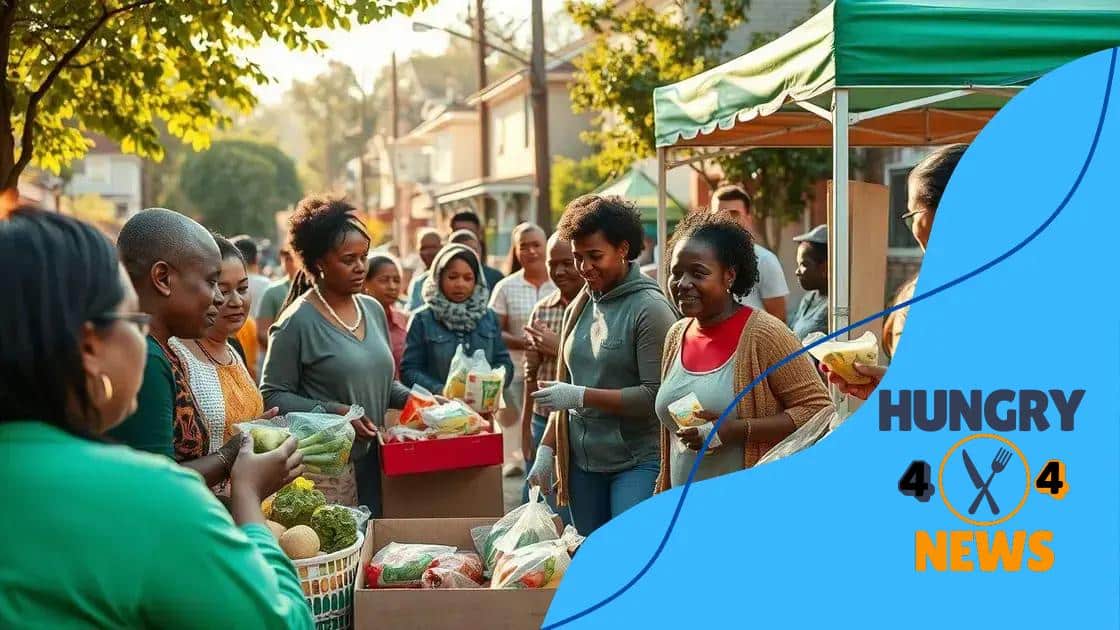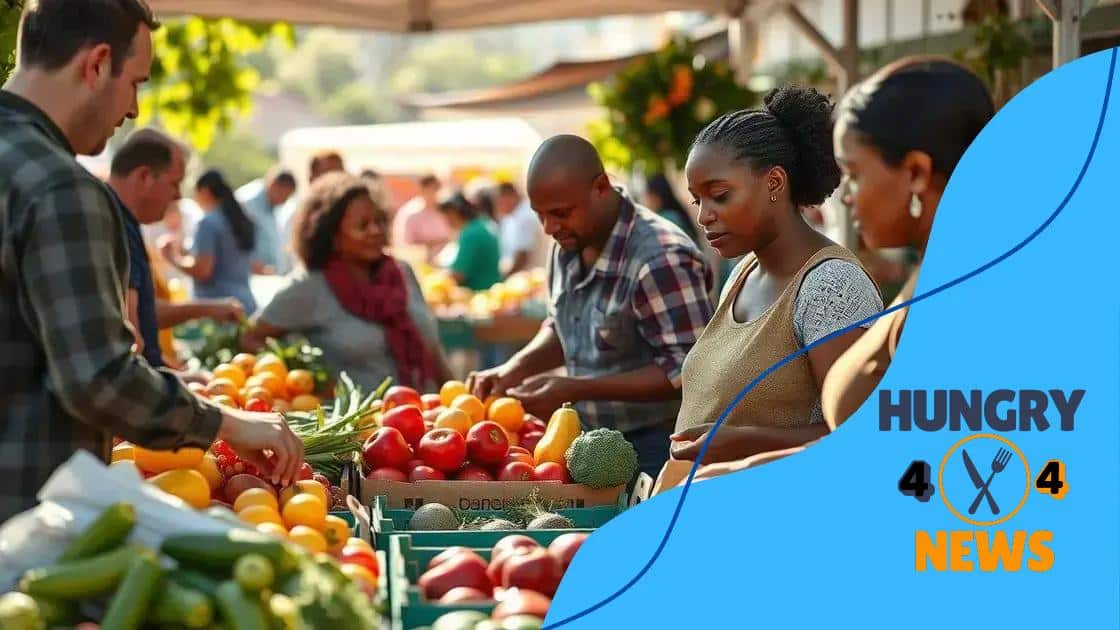Food assistance program expansion in 2025: what to expect

The food assistance program expansion in 2025 aims to improve access to nutritious food for low-income families through increased funding, streamlined applications, and enhanced community engagement.
Food assistance program expansion in 2025 promises to make significant changes in how support reaches those in need. Have you wondered how these adjustments might affect you or your community?
Overview of the food assistance program
The food assistance program plays a vital role in helping communities access the resources they need. Understanding the basics of this program can empower individuals to take advantage of the benefits available.
What is the food assistance program?
A food assistance program provides essential support to families facing food insecurity. It aims to ensure that everyone has access to nutritious meals. Participants typically include low-income individuals and families who need help meeting their food needs.
Key components of the program
- Direct food aid through local pantries and food banks.
- Supplemental Nutrition Assistance Program (SNAP) benefits to purchase groceries.
- Nutritional education and resources to encourage healthy eating habits.
- Community outreach initiatives to spread awareness of available services.
By addressing various aspects of food insecurity, the program can significantly improve the health and well-being of those it serves. It not only provides immediate relief but also fosters long-term food security. Families are encouraged to take part in workshops that promote cooking skills and nutrition, making it easier to make healthier choices.
Understanding how the food assistance program functions can lead to increased awareness and access to resources. As communities combine their efforts to support one another, the impact of the program becomes even more significant. This collaborative approach often leads to greater resilience in the face of food challenges.
Key changes anticipated in 2025
Several key changes are anticipated in the food assistance program by 2025, aiming to improve access and efficiency. Understanding these changes will help communities prepare and adapt to the new landscape of food support.
Increased funding for food assistance
One major change involves an increase in federal funding. More resources mean that local programs can expand their reach. With additional funds, organizations can enhance the quality of food distributed and offer more diverse options to families.
Streamlined application processes
Another significant update will be to streamline the application process. Reducing unnecessary paperwork is crucial. Simplifying these procedures ensures that families can apply for assistance without facing overwhelming hurdles. This change aims to encourage more eligible families to participate.
- Online applications for ease of access.
- Reduced documentation requirements.
- Faster processing times for applications.
As the program evolves, there will also be a focus on improving outreach efforts. Enhanced community engagement strategies will ensure more people know about their options. Programs will work to establish connections with local organizations to inform the public on available resources.
Additionally, educational initiatives will be a priority. Families will receive training on nutrition, cooking, and budgeting. This educational support can empower them to make informed food choices and maximize the benefits of the assistance they receive, thus promoting long-term health and wellness.
Impact on low-income families

The impact on low-income families due to changes in the food assistance program is profound. With updated resources and initiatives, families can expect improved access to nutritious food.
Enhanced Access to Resources
One significant change is the enhanced access to food pantries and local programs. These resources are becoming more available to families. The increase in local and federal support ensures more food is accessible for those in need.
Economic Relief through Food Support
Providing support through food assistance is a vital economic relief measure. Families can redirect funds once spent on food to other essential needs like housing and healthcare. This relief is crucial, especially in tough economic times.
- Reducing food insecurity leads to better health outcomes.
- Assistance programs help stabilize family budgets.
- Access to nutritious food supports children’s growth and education.
Furthermore, families participating in food assistance programs benefit from educational opportunities. They receive information about healthy eating and budgeting, which can empower them to make better choices. Families feel more confident in their ability to provide healthy meals.
Also, the sense of community strengthens through these programs. As families come together to access resources, they create connections and support networks. This engagement fosters a strong community spirit, leading to long-term benefits beyond just food assistance.
How to access new resources
Accessing new resources through the food assistance program is easier than ever, thanks to updated policies and outreach efforts. Families can benefit from various options available to them.
Online Resources
One of the key ways to access these new resources is through online platforms. Many local food banks and assistance programs now offer websites where individuals can find information and apply for aid with just a few clicks. This accessibility is essential for busy families.
Local Community Centers
Community centers play a significant role in connecting families with resources. They often host informational sessions and workshops about food assistance options. Attending these sessions can help families understand what is available and how to benefit from it.
- Check local community boards for announcements.
- Visit community centers to meet with program representatives.
- Engage in workshops to better understand available resources.
Another vital way to access resources is through local partnerships. Many organizations collaborate to provide comprehensive support. For instance, some food banks partner with schools and healthcare providers. This collaboration ensures that families receive not just food assistance but also nutritional education and health resources.
In addition, advocacy groups often distribute information on how to navigate the food assistance system. They provide essential guidance on filling out applications and understanding eligibility requirements. Families can also use social media to stay updated on new initiatives and resources.
Future outlook for food assistance initiatives
The future outlook for food assistance initiatives appears promising, with significant improvements expected. Many programs are evolving to meet the growing needs of communities.
Increased Collaboration
One trend we can anticipate is increased collaboration among various agencies and organizations. By working together, these groups can create more robust support systems for families. Collaborative efforts might include food banks teaming up with schools and healthcare providers to ensure comprehensive support.
Focus on Sustainability
Sustainability will play a crucial role in future initiatives. Programs are beginning to prioritize sustainable practices in sourcing and distributing food. This means more local produce and partnerships with local farmers. Sustainable methods not only help the environment but also strengthen the local economy.
- Implementing community gardens to grow fresh food.
- Encouraging farms to donate surplus crops.
- Reducing food waste through better management practices.
Additionally, technology will become a more significant part of food assistance programs. Many organizations are expected to enhance their digital platforms. This will make it easier for families to find resources and receive support. Online applications and informational websites will likely become standard.
As we look to the future, educational programs will continue to develop. Training sessions on nutrition and budgeting will be more widely available. These initiatives aim to equip families with the tools they need for a healthier lifestyle. Empowering individuals with knowledge is just as important as providing food.
The food assistance program is evolving to better support communities and families in need. As funding increases and collaboration grows, the impact on low-income families can be significant. By accessing new resources and focusing on sustainability, we are moving toward a future where everyone has access to nutritious food. Programs are adopting technology to streamline assistance and provide educational opportunities, empowering families to make informed choices. This positive shift is essential for improving health and well-being in our communities.
FAQ – Frequently Asked Questions about Food Assistance Programs
What changes are expected in food assistance programs by 2025?
By 2025, we expect increased funding, streamlined application processes, and greater outreach to help more families access food assistance.
How can low-income families benefit from food assistance initiatives?
Low-income families can access nutritious food, receive educational resources on healthy eating, and benefit from financial relief to help with other essential needs.
How can I access new food assistance resources?
You can access new resources online through local food banks’ websites, community centers, or by participating in workshops to learn about available support.
What role does sustainability play in food assistance initiatives?
Sustainability focuses on using local produce and environmentally friendly practices, which helps both the economy and the environment while providing food support.





